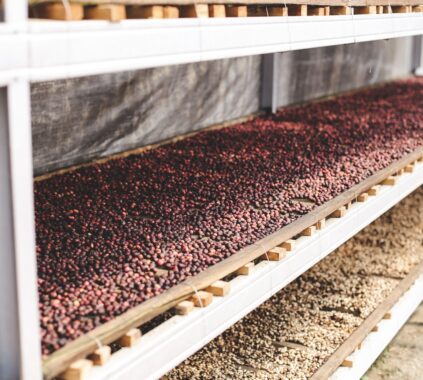Table of Contents
Welcome back, coffee enthusiasts and Italophiles! In today’s blog post, we’re celebrating the marriage of two of our favorite things: coffee and Italian cuisine. Whether you’re a seasoned espresso aficionado or a newcomer to the world of Italian coffee drinks, we’ve got a treat for you. We’ll be diving into the rich history of Italian coffee culture, sharing tips for brewing the perfect espresso, and exploring some delightful coffee-infused recipes that will take your taste buds on a culinary adventure. So, grab your favorite coffee mug, and let’s get started!
Check out this Cookbook “Mangia, A Taste of Italy in America!”

I. A Brief History of Italian Coffee Culture
Though coffee is not native to Italy, the country has played a pivotal role in shaping the global coffee culture. In fact, Italy is often credited with popularizing espresso and introducing the world to a myriad of coffee drinks that we know and love today. But how did this love affair between Italy and coffee begin? Let’s take a stroll down memory lane.
A. The Arrival of Coffee in Italy
While the exact origins of coffee are shrouded in mystery, it is widely believed that the coffee plant originated in Ethiopia before spreading to the Arabian Peninsula. It wasn’t until the 16th century that coffee made its way to Italy, thanks to Venetian merchants who traded with the Ottoman Empire. At first, coffee was considered a luxury item reserved for the elite, but it wasn’t long before it became a popular beverage enjoyed by people from all walks of life.
B. The Birth of Espresso and the Modern Italian Coffee Scene
The invention of the espresso machine in the early 20th century revolutionized the way Italians enjoyed their coffee. The first patented espresso machine, created by Angelo Moriondo in 1884, laid the groundwork for the modern espresso machines we know today. With the rise of espresso, Italy’s coffee culture blossomed, giving birth to iconic coffee drinks like cappuccino, macchiato, and latte. Today, Italian coffee culture is characterized by its emphasis on quality, tradition, and conviviality. From bustling espresso bars to leisurely after-dinner coffee rituals, the love for coffee is deeply ingrained in the Italian way of life.
Espresso Martini Anyone? (Only those of legal drinking age)

II. Mastering the Art of Espresso: Tips and Techniques
For many, the perfect espresso is the holy grail of coffee-making. But what does it take to pull a flawless shot of this rich, aromatic liquid gold? In this section, we’ll share some tips and techniques for brewing espresso that would make even the most discerning Italian barista proud.
Checkout our guide on Espresso!
A. The Importance of Fresh, High-Quality Beans
When it comes to espresso, the quality of your beans can make or break your brew. For the best results, invest in fresh, high-quality beans from a reputable roaster. Look for beans that have been roasted within the last two weeks and store them in an airtight container to maintain their freshness. Remember, different beans can produce different flavors, so don’t be afraid to experiment with various blends to find your perfect espresso.
B. The Art of Grinding
Grinding your coffee beans is a crucial step in the espresso-making process, as it can significantly impact the flavor and extraction of your shot. For the ideal espresso grind, you’ll want a fine, consistent texture that’s similar to powdered sugar. Use a burr grinder for optimal consistency and adjust the grind settings as needed to achieve the perfect extraction time – typically around 25-30 seconds for a double shot.
Checkout our Coffee Grind Guide!
C. Tamping and Dosing
Once you’ve ground your beans, the next step is to accurately dose and tamp your coffee grounds. The ideal dose for a double shot of espresso is typically between 18 and 20 grams, but this can vary depending on your machine and preferences. After dosing, use a tamper to evenly and firmly compress the coffee grounds in your portafilter. This ensures a consistent extraction and a well-balanced shot.
D. Dialing in Your Machine
Espresso machines can be finicky, so it’s essential to dial in your machine to achieve the perfect shot. Pay attention to factors like water temperature, pressure, and extraction time, and adjust your machine settings as needed to find your espresso sweet spot. Remember, practice makes perfect, so don’t be discouraged if your first few shots aren’t up to par – with a little patience and persistence, you’ll be pulling barista-worthy espresso shots in no time.
III. Italian-Inspired Coffee Recipes: A Culinary Adventure
Now that you’ve mastered the art of brewing espresso, it’s time to explore the wonderful world of Italian-inspired coffee recipes. From velvety cappuccinos to delectable coffee-infused desserts, these recipes will transport your taste buds straight to the heart of Italy.
A. Classic Cappuccino
The cappuccino is a beloved staple of Italian coffee culture, characterized by its harmonious balance of espresso, steamed milk, and frothy foam. To make a classic cappuccino, start by pulling a double shot of espresso into a pre-warmed cup. Then, steam and froth your milk, aiming for a velvety, micro-foam texture. Gently pour the steamed milk over your espresso, allowing the foam to rise to the top. For an authentic touch, dust your cappuccino with a sprinkle of cocoa powder or cinnamon.
B. Affogato al Caffè
Affogato al caffè is a divine Italian dessert that combines two of life’s greatest pleasures: coffee and ice cream. To make this simple yet satisfying treat, start by placing a scoop of high-quality vanilla gelato or ice cream in a chilled glass or bowl. Next, pour a freshly brewed shot of hot espresso over the ice cream, allowing it to melt and mingle with the coffee. Serve immediately and enjoy the heavenly marriage of flavors and textures in every spoonful.
C. Coffee-Infused Tiramisu
Tiramisu, which literally means “pick me up,” is a classic Italian dessert that features layers of coffee-soaked ladyfingers, rich mascarpone cheese, and a dusting of cocoa powder. To make a coffee-infused tiramisu, start by brewing a strong batch of espresso and allowing it to cool slightly. In a separate bowl, whisk together egg yolks and sugar until creamy and pale, then fold in mascarpone cheese and a splash of coffee liqueur, if desired. Next, quickly dip the ladyfingers in the espresso, taking care not to oversoak them, and arrange them in a single layer in a serving dish. Spread a layer of the mascarpone mixture over the ladyfingers, then repeat the process to create a second layer. Finish by dusting the top of the tiramisu with cocoa powder, and refrigerate for at least 4 hours or overnight to allow the flavors to meld together. Serve chilled and enjoy this indulgent, coffee-infused delight.

Check out this post on Tiramisu!
D. Iced Coffee Granita
Originating from Sicily, granita is a refreshing, semi-frozen dessert that can be made in a variety of flavors, including coffee. To make an iced coffee granita, start by brewing a batch of strong coffee or espresso and allowing it to cool. Stir in sugar to taste, then pour the mixture into a shallow, freezer-safe dish. Place the dish in the freezer and, using a fork, stir the mixture every 30 minutes, breaking up any ice crystals that form. Continue this process until the granita reaches a slushy, crystalline consistency. To serve, scoop the coffee granita into chilled glasses or bowls and garnish with a dollop of whipped cream if desired. This icy treat is perfect for enjoying on a hot summer day or as a refreshing after-dinner palate cleanser.
IV. Italian and Coffee Just Go Together!
And there you have it Coffee Meets Italy! A journey through the enchanting world of Italian coffee culture, from its storied history to its delectable, coffee-infused recipes. We hope this blog post has inspired you to embrace your inner barista and explore the delightful marriage of coffee and Italian cuisine in your own kitchen. As always, thank you for joining us on this culinary adventure, and be sure to stay tuned for more delicious insights, tips, and experiences from our food blog. Until next time, buon appetito and happy brewing!
Daily Demitasse is a participant in the Amazon Services LLC Associates Program, an affiliate advertising program designed to provide a means for sites to earn advertising fees by advertising and linking to Amazon.com. We also participate in other affiliate programs which compensate us for referring traffic.














